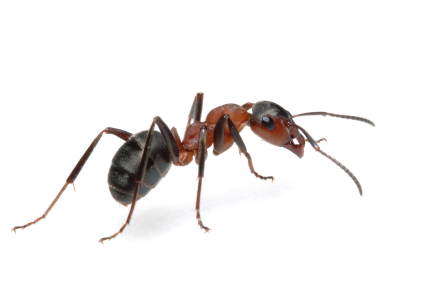In the outside world, carpenter ants are one of nature’s best insects. They transform decayed, fallen trees into compost for new plant growth. Unfortunately, they can wreak havoc on your home. While they are beneficial outdoors, carpenter ants can quickly damage wood and destroy the structural integrity of your home.
What Attracts Carpenter Ants to Your Home?
Carpenter ants are often found outdoors because they prefer moisture and damp environments. When they come indoors, the ants look for areas with damaged or moist wood. If your home is humid or contains a lot of damaged wood, then you could end up with a carpenter ant infestation.
Carpenter Ant Damage
If a carpenter ant colony remains undetected, it can cause extensive damage. Carpenter ants excavate tunnels in wood to make a nest. This can cause structural damage in wood or damage to foam insulation. While it can take years for extensive damage to occur, a large colony can quickly ruin the structural integrity of your home.
Signs That You May Have Carpenter Ants
Carpenter ants will damage any wood that they end up nesting in. If these infestations are left untreated, then the ant colony can develop satellite nests. They rarely nest in dry wood and prefer wood that has been softened by moisture or decay. Often, carpenter ants will get into your home through entry points like cracks, attic vents, telephone lines, electric wires, pipes and foundations. Once they are inside, they like to live in areas like foam panels, wall voids, windows and hollow doors.
The first sign that you may have an infestation is fairly obvious. If you see a carpenter ant in your home, there is an excellent chance that you have or are about to have an infestation. This is not a guaranteed sign of an infestation because carpenter ants will often forage for food far away from their nests.
If the infestation is severe, you will see piles of wood shavings below wooden items. As the carpenter ant burrows into a nest, the wood naturally falls out of the wall. You may also hear rustling noises as the carpenter ants dig through the woodwork. At certain times of the year, large, winged ants will fly out of hidden crevices and the ceilings. If this happens, you can be fairly certain that your home is infested with carpenter ants.
You can also check for the following signs of an infestation:
- Wings from swarmer carpenter ants are found along baseboards, windows and vents.
- A knife can cut through wood that has been infested.
- The wood sounds hollow when you tap it.
- Rustling sounds are heard in infested woodwork.
- The wood suddenly has sections that are smooth and free of debris.
- Sawdust and wood shavings are present near where the ants bored holes.
If you have a problem with carpenter ants, you need to get help before the infestation becomes severe. To prevent damage to your property, contact Abarb Pest Services for all of your pest control needs.
